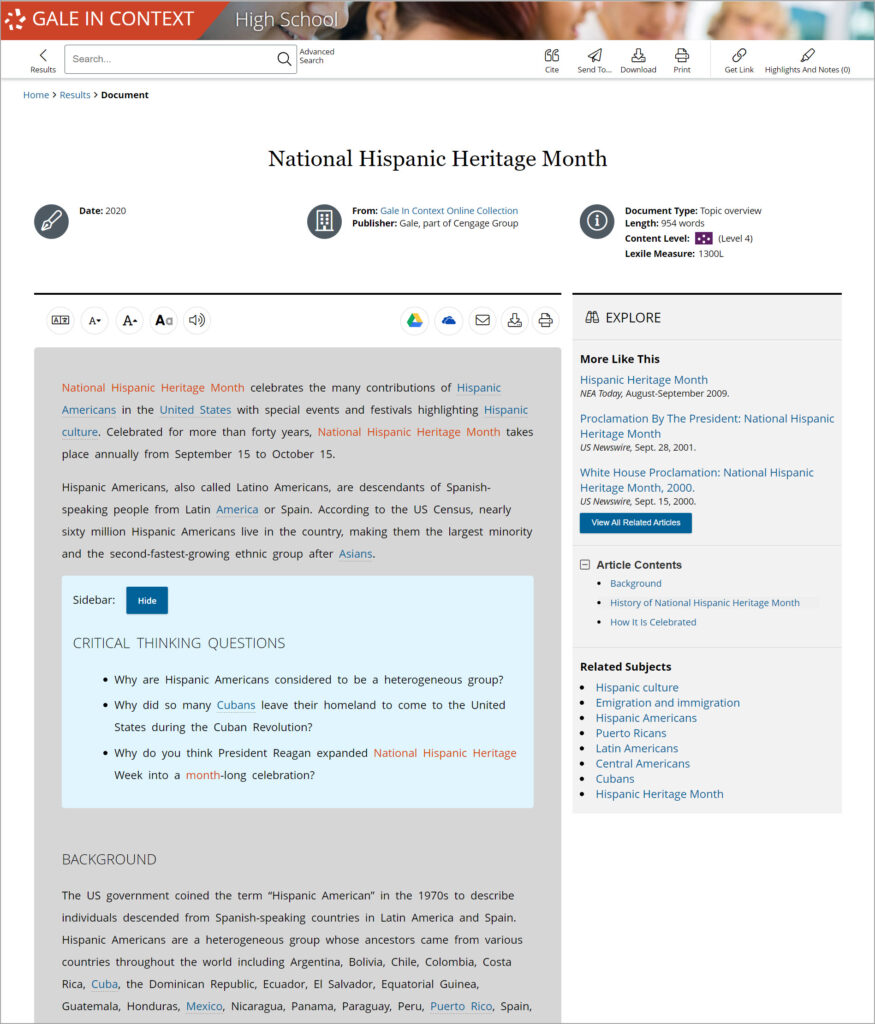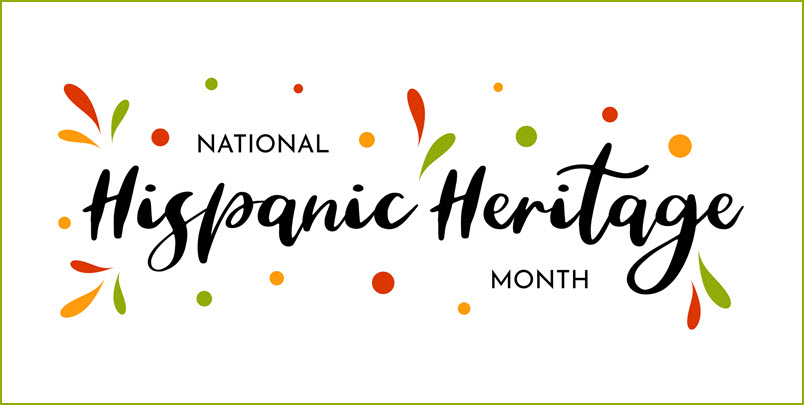| By Gale Staff |
National Hispanic American Heritage Month is September 15 through October 15, and high school educators can capture its cultural and historical relevance in their fall semester lesson planning. Hispanic Heritage Month is an opportunity to recognize the generations of Hispanic and Latinx individuals who have had a meaningful influence on our society. Gale In Context: High School is an excellent tool for teachers looking for ideas to celebrate. Our curated collections contain a wealth of vetted, diverse, and unbiased content, helping educators integrate these essential stories into their classrooms, no matter their subject.
While Congress originally instated Hispanic Heritage Week in 1968, they expanded the observation to become Hispanic Heritage Month in 1988. Unlike other heritage-based holidays that we celebrate throughout the year, Hispanic Heritage Month starts and ends in the middle of two months—September and October. The dates capture the independence days of several Latin American countries, including Guatemala, El Salvador, Honduras, Nicaragua, Mexico, Chile, Costa Rica, and others.
According to the 2020 Census, more than 60 million Hispanic people live in the United States. This group is the most significant racial minority in the country, making up almost one-fifth of the nation’s people. Many Hispanic Americans live along the four primary Mexican border states—California, Texas, Arizona, and New Mexico. However, Hispanic and Latinx people live all over the country, contributing to our communities in many important ways. Teachers and students can dive into Gale In Context: High School’s Hispanic Heritage Month article to learn more.

Consider Hispanic American Contributions to Science
Dr. Ellen Ochoa was born in Los Angeles in 1958. Her parents divorced when she was young, and Ochoa’s mother shouldered most of the parenting duties. Encouraged from an early age to pursue education, Ochoa was a motivated student. An accomplished musician, a spelling bee champion, and a natural in science class, she struggled to decide on her ultimate calling. In college, Ochoa concentrated on physics. By her early 30s, she became the first female Hispanic astronaut in the United States. She joined the crew aboard the Discovery shuttle, spending nine full days in space. Later in life, she served as the director of the Johnson Space Center, and now she helps lead the National Science Foundation.
Hispanic and Latinx individuals have also made—and continue to make—huge contributions to the STEM field. Antonia Novello was the first Hispanic woman to become the U.S. Surgeon General. She helped raise awareness and support for minority women’s health issues and pioneered the fight against the tobacco industry’s targeted advertising toward children. Then there’s biologist Lydia Villa-Komaroff who led the research team that discovered how bacteria could produce insulin and chemist Luis Miramontes who helped invent the first contraceptive pill. Sharing these stories and others with your classroom can offer your students a new, more diverse team of role models in the STEM field.
Appreciate Hispanic Art
Individuals with Hispanic roots have made major contributions to music, film, sports, literature, and art. Frida Kahlo is one such iconic artist, a Mexican-born painter whose self-portraits are worth millions today. Her artistic themes touched on Mexican heritage and female symbolism—she often painted herself in traditional Mexican dress. She died young, but she is nonetheless considered one of the most influential artists of the 20th century. Today, Kahlo’s story and work remain prominent throughout pop culture. Her life has been dramatized in movies and other forms of media, and her face appears on t-shirts and other commercial items worldwide.
Aside from famous names like Frida Kahlo or, notably, Bad Bunny, encourage your students to explore Gale In Context: High School for lesser-known Hispanic and Latinx artists. Find an audio interview from NPR’s Tiny Desk Concert series featuring breakthrough Alt. Latino bands, or listen to samples from a recent Latinx exhibit in Los Angeles. Why not use Hispanic Heritage Month to showcase the incredible talent within this community? Your students might discover a new musician or piece that inspires them!
Study Modern-Day Political Conversations
Hispanic Americans are making big waves in U.S. politics. Figures like Alexandria Ocasio-Cortez, Sonia Sotomayer, and Marco Rubio hold significant positions of influence. The Latinx vote has real power, and Hispanic legislators make up more than 10% of the U.S. House of Representatives. Nonetheless, Hispanics suffer from discrimination and targeted, often controversial legislation.
Use Gale In Context: High School to assist your students in understanding the politics of immigration laws and the economic consequences of deporting undocumented workers. Help students find answers to common misconceptions, such as whether undocumented immigrants take job opportunities from U.S. citizens. Support students in better understanding the political rhetoric that informs racial discrimination against Hispanic and Latinx people and how misguided comments can fuel violence. By introducing your young learners to accurate, unbiased content, you can help dispel misinformation, celebrate diversity, and build empathy.
Create Unforgettable Lesson Plans
For beginning educators or those seeking strategies for integrating Gale products into the classroom, Gale In Context: For Educators can help. Find professional development tools, including how-to guides and webinars, for the most relevant topics in the field. Discover strategies for improving accessibility in your classroom, ready-made lesson plans, and helpful technical solutions.
Throughout the school year, Gale’s education experts develop useful compilations called Content-Specific Training Materials. These collections feature specific ideas and even printable activities dedicated to each month’s different holidays and observances. You can browse these materials in advance to help you brainstorm for various themes and lesson plans. Current collections include Black History Month, Native American Heritage Month, National Poetry Month, and more. Visit Gale’s Support Site often to find new and updated collections.
This fall, don’t miss out on the extensive content housed in Gale In Context: High School. And remember to take advantage of the extra teaching tips and materials available in Gale In Context: For Educators.

